Kit Palmer | February 8, 2018
Wingin’ It
We get our first taste of the new-from-the-road-up Honda GL1800 Gold Wing Tour DCT.
2018 Honda GL1800 Gold Wing Tour DCT | FULL TEST | A big place like Texas is an ideal setting to test a big motorcycle like the Honda Gold Wing. As in the song, I too rode up in to Austin and saw miles and miles of Texas; however, I saw them while aboard the all-new and completely redesigned 2018 Honda GL1800 Gold Wing Tour DCT.

The Gold Wing has come a long ways since its birth as a naked-style standard in 1975 to what it is today—a massive, yet sporty, 1833cc flat-six luxury tourer designed to get you from one end of the country to the other in extreme comfort and style.
One of the keys to the Gold Wing’s original success was its 999cc liquid-cooled horizontally opposed four-cylinder engine that produced great power and was amazingly smooth, not to mention extremely reliable, a perfect combination for long-distance touring. Honda might not have planned it at the time, but it created a new genre of motorcycle riding thanks to that very first Honda Gold Wing.

The Gold Wing has seen many changes over its lifespan but it’s been a while since the last one 17 years ago, when, in 2001, it got fuel injection, an aluminum frame, optional ABS and a major facelift.
Like the ’01 Wing, the ’18 got a wheel-to-wheel overhaul. Suspension, engine, bodywork and electronics have all been redesigned for a lighter, more compact, more technologically advanced and better performing package.

PHOTOGRAPHY BY KEVIN WING AND BRIAN J. NELSON
Southern Comfort
Honda chose Austin, Texas to show off its latest pride and joy and had planned a 400-mile two-day ride with an overnight stay, but forecasted freezing rain, snow and ice cut our ride in half to just one day and 200 miles. Now, I realize that 200 miles is nothing for most Gold Wingers—heck, you often do that before breakfast—but I felt this was still plenty enough road to give me a good feel for what the new Gold Wing is all about. I spent the day on the Gold Wing Tour DCT that is fitted with Honda’s unique seven-speed automatic dual clutch transmission system; non-DCT Wings come with six-speed manual transmissions.
Honda has five versions in its line of Gold Wing models: Gold Wing and Gold Wing DCT (both come without a trunk, a shorter windscreen and other minor differences, not to mention a smaller price tag), and Gold Wing Tour, Gold Wing Tour DCT and Gold Wing Tour DCT Airbag.
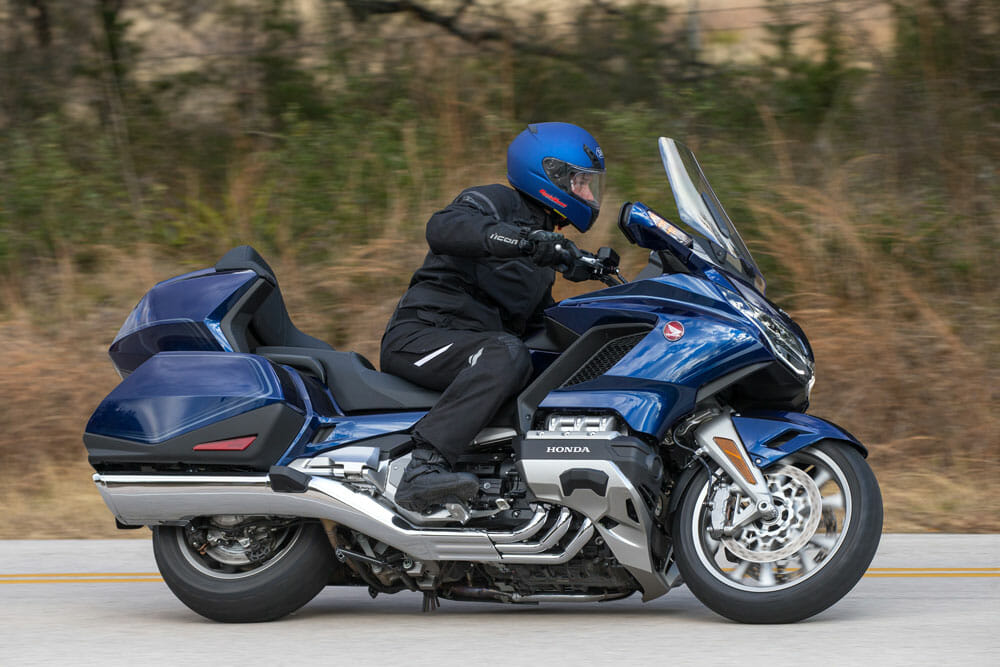
The first thing that really stood out in my mind with the ’18 Wing was the improved ergonomics. It feels much roomier now, and this became even more evident when I hopped on a 2017 Gold Wing and jammed down the road on it for a quick back-to-back comparison. Whoa! What a difference. The ’17 actually felt cramped compared to the ’18. This came as quite a shock to me because I had never before thought of the old Gold Wing as being tight in the cockpit. Even though I still think the ’17 is certainly ergonomically friendly, the ’18 is even more so—at least for my 6’1” frame. I like how Honda reduced the reach of the handlebars and moved the footpegs back on the ’18. What a difference.
 Despite all the changes, there is no mistaking that the 2018 Gold Wing is still very much a Gold Wing.
Despite all the changes, there is no mistaking that the 2018 Gold Wing is still very much a Gold Wing.
While sitting at the controls, the ’18 Wing feels smaller and distinctively narrower than ’17, which has a noticeably wider dash and windscreen than the 18. Honda says this is because of the ’18’s shorter engine and new linked, double-wishbone front-suspension system, which allowed them to move the rider position farther forward and bring the rider closer to the screen. As a result, they could reduce the overall size of the windscreen itself.
And speaking of the windscreen, the ’18’s electronically adjustable windscreen is a major upgrade over the previous fixed screen which, for me, only came up to eye level; now, in the full up position, it covers my entire helmet for a buffet-free ride.
Although I did not have a passenger, I spoke with other passengers on our ride who also thought the new ‘Wing was very comfortable and really loved the new heated backrest. It was a big hit with them. I too enjoyed the ‘Wing’s heated seat, as I did the heated grips that easily kept my hands warm, even through my thick winter gloves.
Honda put a lot of effort into improving aerodynamic efficiency and air management for the rider. They claim aerodynamic efficiency has been improved by 11.8 percent—I’ll just have to trust them on that. But I do know that with the new adjustable windscreen and a new flap on the dash to improve airflow to the rider, the ride from the cockpit is quiet and, again, very comfortable.
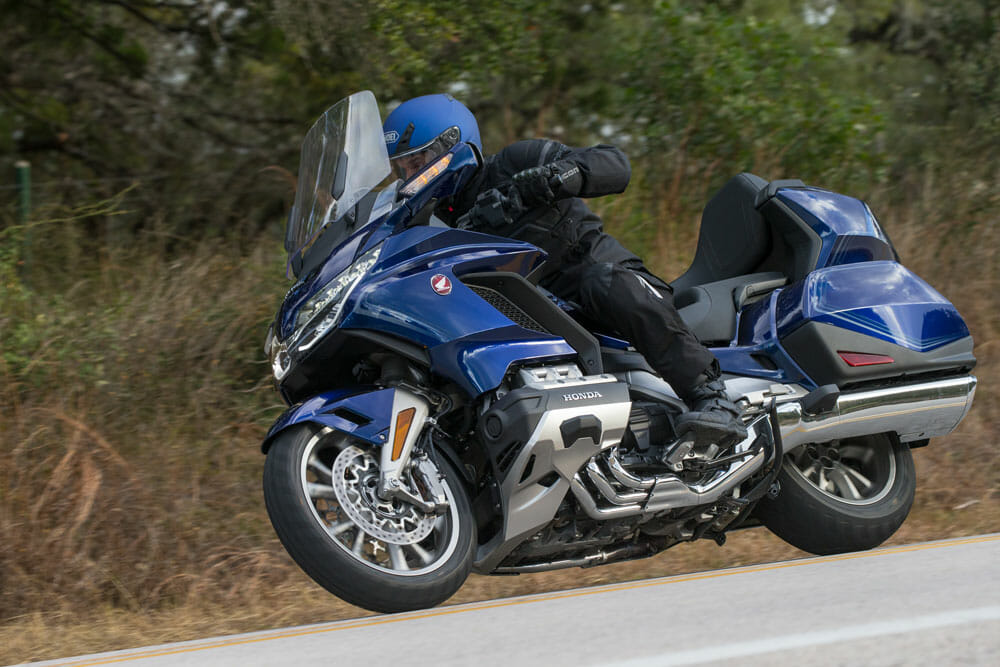 You can easily feel the nearly 90 pounds in reduction of weight. Nice to see the headerpipes again.
You can easily feel the nearly 90 pounds in reduction of weight. Nice to see the headerpipes again.
GEAR ID’d
JACKET: Alpinestars Drystar
PANTS: Alpinestars Andes V2 Drystar
BOOTS: Alpinestars Radon Drystar
GLOVES: Alpinestars Drystar
HELMET: Shoei RF-SR
Super Suspension
I was perhaps most curious about the Gold Wing’s new double-wishbone front-suspension system. Honda says its new double-wishbone design has multiple benefits, the first being a reduction (30 percent, Honda claims) in shock transmitted to the handlebars, an inherent problem with conventional telescopic forks because of the friction (aka stiction) between the outer and inner tubes. You don’t have this problem with this system.
Also, with the double-wishbone design, the front wheel travels straight up, instead of up and toward the bike, which means the wheelbase never changes—for improved stability and control—and that the engine can be position farther forward, which has many benefits, such as the one mentioned earlier. Another one is that a higher percentage of weight is now on the front wheel, which Honda says is a good thing because it contributes “significantly to the bike’s responsive, nimble handling and overall sporty attitude.”
All I can say is that it works. The ride up front is silky smooth yet feels very solid and stable at both high and low speeds. And there is very little front-end diving when you grab a lever full of brakes (which are linked). However, there is no diving at all when you chop the throttle or when only applying the rear brake pedal. As a result, the new Gold Wing feels very balanced and planted at all times, including just before, during and right after a turn, and even under hard braking. Honda deserves a big kudos for its new double wishbone front suspension design.
Overall handling is improved without question. The new chassis results in a super-solid and stable ride and goes where you point it without argument, much of which has to do with dropping over 80 pounds in weight. The Gold Wing was already a pretty sporty-handling bike for its size; it feels even sportier now.
 The new roomier ergos eliminate the need to stop in every town to stretch. Just keep on going!
The new roomier ergos eliminate the need to stop in every town to stretch. Just keep on going!
Grab A Handful
The all-new Unicam engine, which is 13.7 pounds lighter, is still silky smooth; overall, it feels—and sounds (though with a little bit more aggressive tone)—much like the previous engine but with a tick more midrange power. In general, power increase isn’t dramatic over the previous engine, but it does feel a little snappier overall and is supposedly a lot more fuel-efficient. That is why it holds about a gallon less fuel but still gets the same fuel range—at least that’s what we are told. Haven’t been able to test that claim yet.
When it comes to the transmission you have two options: now six-speed (formerly five-speed) manual (traditional shifting) and seven-speed DCT (Dual Clutch Transmission, aka automatic). I spent the day on the DCT version and loved it, but I knew I would since I’m already very familiar with Honda’s DCT system, having previously spent a good deal of time on the DCT-equipped Africa Twin and VFR1200X, and I’m a big fan. The Gold Wing gets the very latest version (generation three) of this amazing and seemingly reliable system and it’s the smoothest DCT yet; personally, I wouldn’t even consider buying the manual version of the Gold Wing. DCT just makes living life on the road that much simpler and less fatiguing for those really long days in the saddle; plus, it’s actually a lot of fun. And, if you want, you can easily switch over to manual mode and chose your own shift points via the shifters on the left handlebar.
Another advantage of DCT is that you get both reverse, and Walking (forward) modes; the manual Gold Wing Tour just gets reverse, and the standard manual-transmission Gold Wing model gets neither.
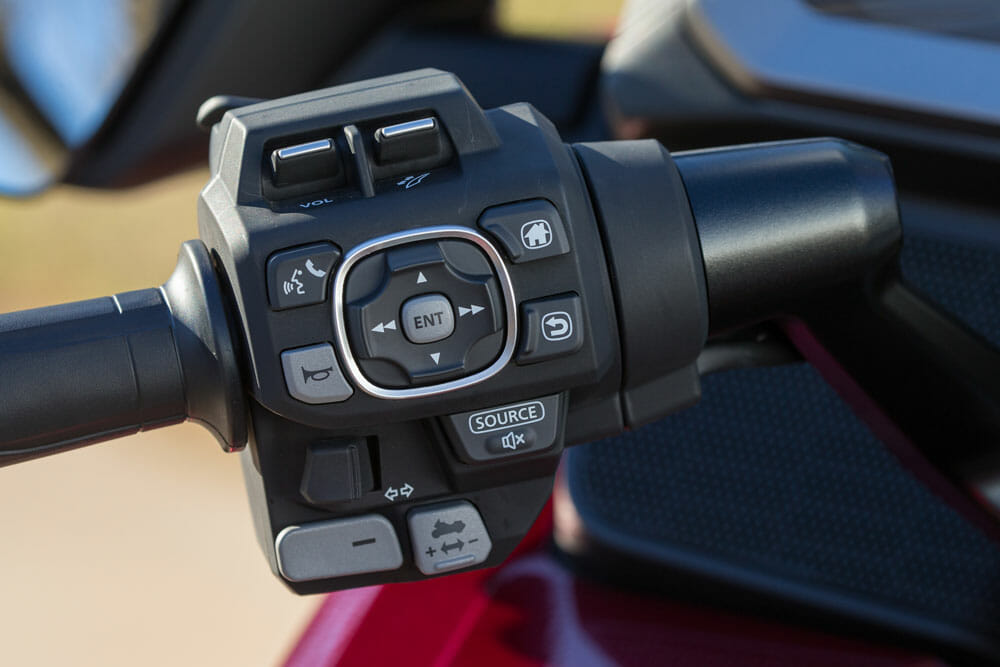 For safety, most of the important control buttons are located on the left handlebar. Many of the center controls are locked out once you start rolling.
For safety, most of the important control buttons are located on the left handlebar. Many of the center controls are locked out once you start rolling.
Thanks to the bike’s new electronic throttle-by-wire system, you get more rider aids with the 2018 Gold Wing, like Honda Selectable Torque Control (aka traction control, which, by the way, can be turned off), Hill Start Assist, fine-tuned cruise control and multiple riding modes. The new Gold Wing has four of them: Touring (for expressway, long-distance cruising), Sport (for winding roads), Economy (for suburbs and cruising) and Rain (for wet or dirt roads). And all four are useful and very distinctive; you can easily tell the difference from one mode to the other. I thought touring mode was a good compromise of all four and the mode I preferred to be in most of the time. Sport mode keeps the engine in a higher rev range, good for immediate throttle response on twisty roads.
Suspension damping also automatically adjusts for whichever mode you’re in, such as stiffer for Sport and softest for Rain. I, however, did not notice the suspension changes, which probably means they are tuned well to each mode.

A really cool design of the new engine is the Integrated Starter Generator (ISG), which combines generator and starter-motor functions; this alone saves 5.3 pounds and reduces noise during startup.
Another cool design is that you can now actually see the exhaust pipes; before, they were completely hidden by the lower cowling. This, in my opinion, gives the Gold Wing an improved look and no one will mistake for an oversized scooter.
 Passengers seems to really enjoy the heated backrest. Less storage might be an issue for some long-distance riders.
Passengers seems to really enjoy the heated backrest. Less storage might be an issue for some long-distance riders.
Entertainment Center
The Gold Wing’s new Apple CarPlay—which allows you to connect via a cable to your iPhone and show maps, contacts and music via the bike’s seven-inch full-color Thin Film Transistor (TFT) display—works well. Apple CarPlay also gives you access to phone calls and text messages. Android users, your time will come.
There is a handy storage compartment for your phone—any phone—which can, of course, also be paired to a Bluetooth headset, like the new Sena 30K that I used on this ride. There is a bit of a learning curve as to getting the phone paired with the motorcycle and your headset, but once that’s been accomplished, you’re good to go, and then it’s just a matter of pushing buttons and figuring out what does what. By lunch, I pretty much had it all mastered. The most-used buttons are located on the left handlebar so you don’t have to take your hands off the bars—Honda does not want you to do that. The center jog wheel is locked out once you start rolling; you can still operate the hard buttons, though. I spent most of my ride listening to Pandora while watching our route roll by in maps mode on the navigation screen.
The new Gold Wing uses a Smart Key, which gives you the remote ability to unlock the saddlebags and rear trunk, and easily operate the steering lock and security functions.
The Gold Wing Tour models all come with four audio speakers—two up front and two by the passenger compartment. I tried listening to my music via the bike’s external speakers but sound quality is no match for the Sena 30K helmet headset I was using.
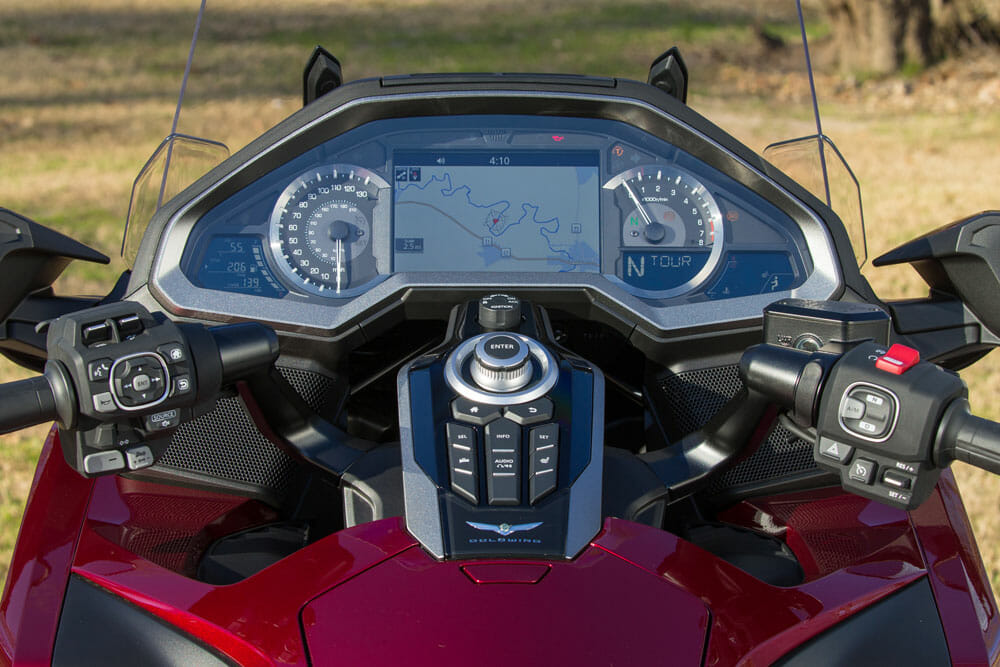 The cockpit is noticeably narrower. There is lot to learn when it comes to the ’Wing’s infotainment center but you’ll have it all figured out by the end of the day.
The cockpit is noticeably narrower. There is lot to learn when it comes to the ’Wing’s infotainment center but you’ll have it all figured out by the end of the day.
I Need My Space
When it comes to storage this is one area that some might feel that the new Gold Wing took a big step backwards, because there is less of it.
So why did Honda give you less storage space? Well, they did the research and discovered that most Gold Wing owners do mostly one or two overnight ride and don’t really need massive storage, and since Honda wanted to give the new Wing a sleeker and sportier look, they chose to go with the smaller 30-liter side bags, which is something that California lane-splitters and riders who commute on their Gold Wings will surely like. The Wing’s smaller 50-liter trunk struggles to hold two full-face helmets (it depends on the size and models of the helmets) but the bike does come with an external helmet lock that will accommodate two helmets at one time. I would like to see a specific compartment to safely store a laptop computer; after all, who goes anywhere without their laptop these days? As of now, it’s an awkward fit.
You can bet Honda will offer larger bags/trunks as accessories, or maybe as an option, in the future. Honda does, however, already has a long list of accessories for the new Wing, but larger bags aren’t on it yet.
 It’s still very much a Gold Wing. Just better.
It’s still very much a Gold Wing. Just better.
Roundup
My first experience on the new Gold Wing was definitely a positive one. I’m happy to say that in spite of all of the changes, the all-new Gold Wing still feels like a Gold Wing—only better. It still as that Gold Wing-smooth engine, perky power and remarkably nimble handling. It’s just that it does all of these things a little, if not, a lot better.
I can see how some might not approve of the smaller-capacity bags and smaller-capacity fuel tank, as we all have different needs and wants when it comes to long-distance touring, but, for me at least, these things were not game changers in my roadbook when it comes to the big picture. Not even close.
It appears that Honda has raised the bar once again when it comes to the luxury-touring market, a market that this bike created. CN
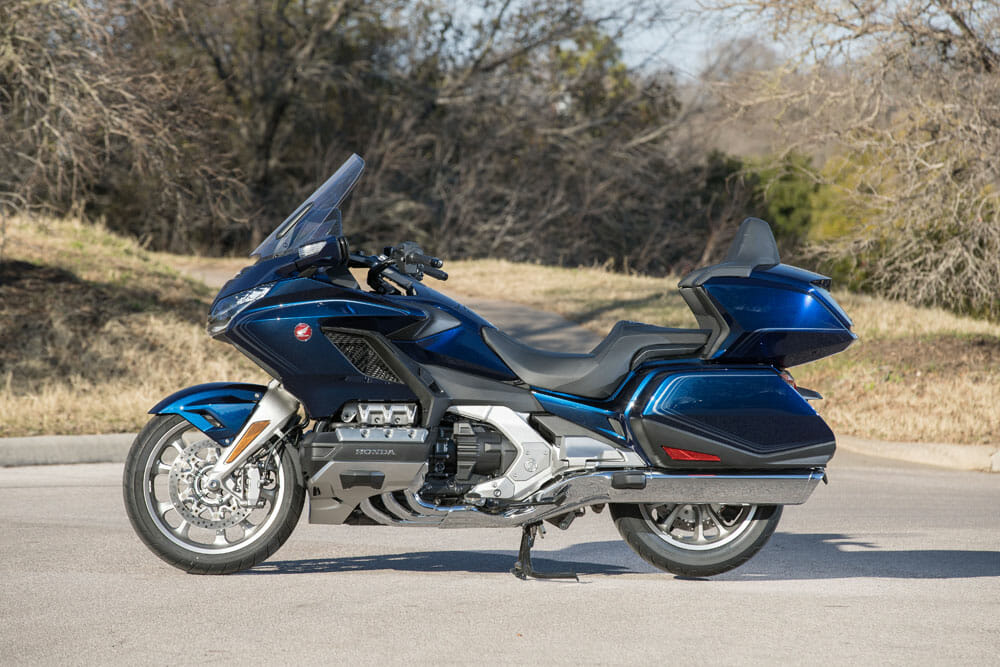
SPECIFICATIONS
|
|
|
2018 Honda GL1800 Gold Wing Tour DCT
|
|
ENGINE TYPE:
|
Liquid-cooled, 4-stroke, single overhead Unicam, 18- valve, horizontally opposed 6 cylinder
|
|
BORE X STROKE:
|
73 x 73mm
|
|
COMPRESSION RATIO:
|
10.5:1
|
|
INDUCTION:
|
Single throttle w/50mm bore, Throttle By Wire (TBW)
|
|
IGNITION:
|
Full transistorized ignition
|
|
STARTER:
|
Electric w/integrated Starter Generator System (ISG)
|
|
TRANSMISSION:
|
7-speed automatic DCT w/Walking Mode F/R
|
|
CLUTCH:
|
(2) multi-plate wet clutches
|
|
FINAL DRIVE:
|
Shaft
|
|
FRONT SUSPENSION:
|
Double-wishbone front-suspension system w/Showa shock absorber, electronic preload adjustable
|
|
REAR SUSPENSION:
|
Pro-Link system w/Showa shock absorber, electronic preload adjustable
|
|
FRONT WHEEL TRAVEL:
|
4.3 in.
|
|
REAR WHEEL TRAVEL:
|
4.1 in.
|
|
FRONT BRAKE:
|
2 radially mounted 6-piston Nissin calipers w/320mm rotors, electronically controlled combined ABS
|
|
REAR BRAKE:
|
Single 3-piston Nissin caliper w/316mm rotor, electronically controlled combined ABS
|
|
FRONT TIRE:
|
130/70-18
|
|
REAR TIRE:
|
200/55-R16
|
|
RAKE:
|
30.5°
|
|
TRAIL:
|
109mm
|
|
WIDTH:
|
35.6 in.
|
|
HEIGHT:
|
56.3 in. low windscreen; 61.2 in. high windscreen
|
|
SEAT HEIGHT:
|
29.3 in.
|
|
GROUND CLEARANCE:
|
5.1 in.
|
|
WHEELBASE:
|
66.7 in.
|
|
FUEL CAPACITY:
|
5.5 gal.
|
|
CURB WEIGHT (full fuel, ready to ride):
|
842 lbs.
|
|
COLORS:
|
Candy Ardent Red; Pearl White; Pearl Hawkseys Blue
|